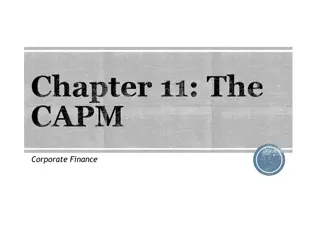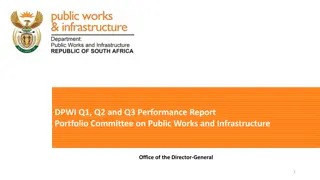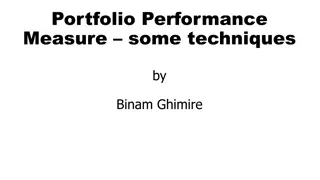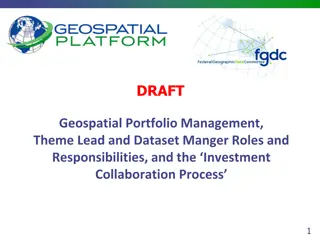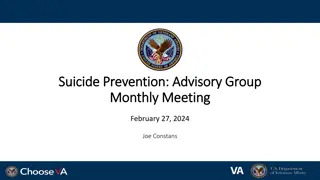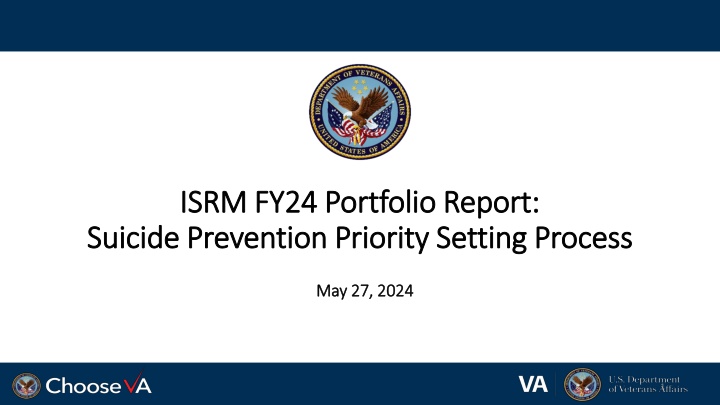
Suicide Prevention Critical Research Priorities Development Process
Explore how the Suicide Prevention AMP identified critical research priorities through a 3-phased approach: understanding existing federal research priorities, gathering VA stakeholder input, and finalizing the critical research priorities. This detailed process ensures research efforts are directed towards addressing key areas in Veteran suicide prevention.
Download Presentation

Please find below an Image/Link to download the presentation.
The content on the website is provided AS IS for your information and personal use only. It may not be sold, licensed, or shared on other websites without obtaining consent from the author. If you encounter any issues during the download, it is possible that the publisher has removed the file from their server.
You are allowed to download the files provided on this website for personal or commercial use, subject to the condition that they are used lawfully. All files are the property of their respective owners.
The content on the website is provided AS IS for your information and personal use only. It may not be sold, licensed, or shared on other websites without obtaining consent from the author.
E N D
Presentation Transcript
ISRM FY24 Portfolio Report: ISRM FY24 Portfolio Report: Suicide Prevention Priority Setting Process Suicide Prevention Priority Setting Process May 27, 2024 May 27, 2024 1
1 Executive Summary 1 3-4 Executive Summary 2 5-9 Phase 1: Understanding Existing Suicide Prevention Research Priorities Table of Table of Contents Contents 3 10-20 Phase 2: Collecting Stakeholder Priorities 4 21-32 Phase 3: Developing AMP Priorities 5 33-44 Appendix 2
Executive Summary Executive Summary | | Background and Analysis Objective Background and Analysis Objective BACKGROUND In April 2022, The VA Office of Research and Development (ORD) formally announced the formation of the Investigators, Scientific Review, and Management unit (ISRM) and its decision to transition from the current discipline-based model of research funding and management (the Services) to the Portfolio-based model. This transformation has required many changes across ISRM, and a key change was the development of the new Portfolios. ISRM is creating 2 kinds of Portfolios: Broad and Actively Managed. The Broad Portfolios are replacing the existing services and intend to capture a wide array of projects while the Actively Managed portfolios are more specific around a Veteran health need. ANALYSIS OBJECTIVE To ensure that Actively Managed Portfolios (AMPs) are directing research towards the right areas within their field of Veteran need, each AMP needs create Critical Research Priorities. These Priorities are meant to identify short and long- term research focus areas in the given field to enhance real-world impact of research. This report details the process used by the Suicide Prevention AMP to develop its Critical Research Priorities. The AMP started by examining a wide set of priorities set by federal agencies to understand the various fields of research in Suicide Prevention and then narrowed the categories down by capturing VA stakeholder priorities through offline surveys and live discussions.
Executive Summary | Suicide Prevention AMP Executive Summary | Suicide Prevention AMP Priority Setting Priority Setting Suicide Prevention developed its Critical Research Priorities through the 3-phased approach detailed below: Phase 1: Understanding Existing Suicide Prevention Priorities in Federal Research The first step in Priority Setting was to understand existing suicide prevention research priorities across the federal research landscape. In November 2023, with support from the VA Quality Enhancement Research Initiative (QUERI), the Portfolio workgroup collected and categorized 186 priorities set by various federal agencies into a scoring matrix that served as a framework to map VA Stakeholder priority areas of interest in the next Phase. Phase 2: Collecting Key VA Stakeholder Priorities The next step was to gather input and priorities from key stakeholders in the VA suicide prevention space. The team deployed a survey and hosted four discussion sessions with investigators from the Suicide Prevention Research Impact Network (SPRINT), the Veterans Engagement Council, Chief Medical Health Officers (CMHOs), and leads from Veteran Integrated Service Networks (VISNs). By triangulating all the feedback, the team landed on 10 critical research priorities for further consideration. Phase 3: Finalizing the Suicide Prevention AMP Critical Research Priorities In the final phase, a survey administered to the SPRINT, CMHOs, VEC stakeholders narrowed down the 10 priorities into 5 critical research priorities: 1) Lethal Means Safety, 2) Community-based interventions, 3) Family, social network-based interventions and postventions, 4) Psychotherapies and other non-somatic interventions, and 5) Risk screening, predictive analytics. Subject matter experts (SMEs) in each of the 5 priorities were contacted for their thoughts on research questions in their respective fields in order to provide the Suicide Prevention Executive Committee with a clear picture of the priorities and the kind of research that will come of out the priorities in the coming years. Phase 3 will culminate with a June 2024 Consensus Panel meeting where the Suicide Prevention Executive Committee will vote to rank research priorities for the Portfolio. 4
Phase 1: Understanding Existing Suicide Prevention Priorities in Federal Research The first step in Priority Setting was to understand existing suicide prevention research priorities across the federal research landscape. In November 2023, with support from the VA Quality Enhancement Research Initiative (QUERI), the Portfolio workgroup collected and categorized 186 priorities set by various federal agencies into a scoring matrix that served as a framework to map VA Stakeholder priority areas of interest in the next Phase.
Phase 1: Understanding Existing Suicide Prevention Priorities in Federal Research Phase 1: Understanding Existing Suicide Prevention Priorities in Federal Research Phase 1 had three key steps: 1.1 Identify existing Suicide Prevention Priority Sources 1.2 Categorize Priorities into Methods or Risk Factors 1.3 Develop a Priority Matrix 6
1.1 Identify existing Suicide Prevention Priority Sources 1.1 Identify existing Suicide Prevention Priority Sources The Suicide Prevention AMP workgroup gathered suicide prevention research priorities from 12 leading organizations and agencies. Some organizations had multiple publications around Suicide Prevention priorities and others also referred to research articles. The group sourced priorities from a total of 26 sources from the 12 organizations below. American Psychological Association Centers for Disease Control and Prevention American Foundation for Suicide Prevention Defense Health Agency (DHA) Department of Defense Indian Health Service National Action Alliance for Suicide Prevention (NAASP) Substance Abuse and Mental Health Services National Alliance on Mental Illness National Institute of Mental Health Veterans Health Administration White House Note: A full list of sources is located on slide 33 in the Appendix
1.2 Categorize Priorities into Methods and Risk Factors 1.2 Categorize Priorities into Methods and Risk Factors The group gathered a total of 186 suicide prevention research priorities and then defined a process to evaluate and categorize these priorities. Evaluation of Priorities Process Create keyword categories based on the priority language. These categories were either a research method (e.g., biology/genomics, continuous monitoring) or a suicide risk factor (e.g., firearms, substance abuse) Decision Rule 5 or more occurrences of a keyword within the priorities resulted in a new category. For example, Community Interventions appeared 5+ times across the priorities so it was determined to be a method category 8
1.3 Develop a Priority Matrix 1.3 Develop a Priority Matrix The categories created from the federal agency s priorities formed this priority matrix. Each category resulted in either a method or procedure listed in the columns of the matrix, or a risk factor listed in the rows of the matrix. The matrix acted as a framework to map VA Stakeholder priority areas of interest in Phase 2. Risk Factors Older Veterans Younger Veterans Female Veterans Substance Abuse Medical Disease Justice InvolvementLGBTQ Trauma/ Moral Injury Mental Health Firearms Race/Ethnicity SDOH TBI Cross-Cutting Category Biological mechanisms and genetic contributions Suicide risk screening, evaluation effectiveness, and processes within VA Machine-based suicide risk algorithms Research Methods/Procedures Technology to assess risk and provide interventions, self-management strategies Family and social network- based interventions and postventions Psychotherapies and other non-somatic interventions Psychotherapy and other Non-Somatic Interventions Community-based interventions Educational or messaging offerings Precision Medicine Postvention Cross-Cutting
Phase 2: Collecting Key VA Stakeholder Priorities The next step was to gather input and priorities from key stakeholders in the VA suicide prevention space. The team deployed a survey and hosted four discussion sessions with investigators from the Suicide Prevention Research Impact Network (SPRINT), the Veterans Engagement Council, Chief Medical Health Officers (CMHOs), and leads from Veteran Integrated Service Networks (VISNs). By triangulating all the feedback, the team landed on 10 critical research priorities for further consideration.
Phase 2: Collecting Key VA Stakeholder Priorities Phase 2: Collecting Key VA Stakeholder Priorities Phase 2 had four key steps: 2.1 Survey SPRINT Stakeholders on Priorities 2.2 Populate Priority Matrix with SPRINT Stakeholder Priorities 2.3 Collect Live Stakeholder Feedback 2.4 Determine Top 10 Priorities 11
2.1 Survey SPRINT Stakeholders on Priorities 2.1 Survey SPRINT Stakeholders on Priorities Goal Understand VA stakeholders current sentiment on priorities for VA Suicide Prevention research, and how it overlapped with existing Suicide Prevention priorities across the federal space. Survey Methodology Respondents: Investigators within the Suicide Prevention Research Impact Network (SPRINT) database. SPRINT is a national collaborative network of researchers looking to further the field of Suicide Prevention research. Key Question Area: Identify up to 10 research areas for which there are significant gaps in extant knowledge and for which research support is needed. Response Count: 54 Note: The text of the Questionnaire is located on slide 34 in the Appendix
2.2 Populate Priority Matrix with SPRINT Stakeholder Priorities 2.2 Populate Priority Matrix with SPRINT Stakeholder Priorities The priorities captured in the survey were then coded into the Priority Matrix, giving #1 priorities a weight of 10, #2 priorities a weight of 9, and so on. In the final column and row, the workgroup totaled priorities by category, with higher sums indicating higher priorities. Risk Factors Firearms / Lethal Means Safety Older Veterans Younger Veterans Female Veterans Substance Abuse Medical Disease Justice Involvement Trauma/ Moral Injury Category Race/Ethnicity SDOH TBI LGBTQ Mental Health Cross-Cutting SUM Biological mechanisms and genetic contributions 0 0 0 0 0 0 0 0 0 0 0 0 0 45 45 Suicide risk screening, evaluation effectiveness, and processes within VA 0 5 5 0 0 8 0 10 0 0 0 0 3 25 56 Machine-based suicide risk algorithms 0 0 0 0 0 0 0 0 0 0 0 0 0 22 22 Technology to assess risk and provide interventions, self- management strategies Family and social network- based interventions and postventions 0 0 0 0 0 0 0 0 0 0 0 0 0 13 13 Research Methods/Procedures 6 0 0 0 0 0 0 0 0 0 0 0 0 13 19 Psychotherapies and other non-somatic interventions 0 0 0 0 0 0 0 0 0 0 0 0 1 29 30 Psychotherapy and other Non-Somatic Interventions 25 0 0 0 0 22 0 0 0 0 5 5 1 42 100 Community-based Interventions 7 0 5 0 0 0 0 0 0 0 0 0 0 56 68 Educational or messaging offerings 10 0 0 0 0 0 0 0 0 0 0 0 0 17 27 Precision Medicine 0 0 0 0 0 0 0 0 0 0 0 0 0 6 6 Postvention 0 0 0 0 0 0 0 0 0 0 0 0 0 16 16 Cross-Cutting SUM 49 97 34 39 3 13 25 25 16 16 32 62 2 2 4 14 4 4 5 5 31 36 6 11 18 23 5
2.2 Populate Priority Matrix with SPRINT Stakeholder Priorities 2.2 Populate Priority Matrix with SPRINT Stakeholder Priorities Category Priority Score Using the scores from the Priority Matrix, 8 categories of Suicide Prevention research emerged as leading priorities. These scores were created by assigning a survey response to a certain cell in the matrix and the responses that were the #1 priority were given a score of 10, #2 priority were given a score of 9, and so on. Aggregated results are below. Psychotherapy and other Non-Somatic Interventions Firearms / Lethal Means Safety Community-based Interventions Social Determinants of Health Suicide risk screening, evaluation effectiveness, and processes within VA Biological mechanisms and genetic contributions Older Veterans LGBTQ Psychotherapies and other non-somatic interventions Educational or messaging offerings Female Veterans Mental Health Machine-based suicide risk algorithms 100 97 68 62 56 45 39 36 30 27 25 23 22 Family and social network-based interventions and postventions 19 Postvention Race/Ethnicity Medical Disease 16 16 14 Technology to assess risk and provide interventions, self- management strategies Younger Veterans Trauma/ Moral Injury Precision Medicine Justice Involvement TBI Substance Abuse 13 13 11 6 5 4 2 14
2.3 Collect Live Stakeholder Feedback 2.3 Collect Live Stakeholder Feedback Goal Gather feedback from key stakeholder groups to refine the 8 categories from the Priority Matrix. Method To ensure the priorities for the Suicide Prevention Portfolio are representative of the interests across stakeholder groups, the Portfolio workgroup collected input during live meetings with: Veteran Engagement Council Leads of the Veteran Integrated Service Network (VISN) Chief Mental Health Officers Suicide Prevention Research Impact Network (SPRINT)
2.3 Collect Live Stakeholder Feedback: 2.3 Collect Live Stakeholder Feedback: Veteran Engagement Council Veteran Engagement Council Key Questions for Audience: Research Priorities Discussed during Meeting Hard to Reach Veterans (Isolating Veterans/ Veterans not in VA care/ Rural Veterans / Transitioning to civilian) Continuity of Care* Community Research (including family) Developing Novel Treatments (including provider perspective) Moral Injury/Spiritual Lethal Means Safety Messaging Peer Support Messaging Data Studies Racial/Ethnic/Sexual Minorities Brain/TBI/Genomics 1. What suicide prevention research topics come to mind as most important for Veterans from your perspective? 2. Are there specific patient populations it would be important to study (if this has not come up)? 3. Are there any research topics you don t think are as high a priority? 4. Are there particular topics within this area that come to mind that would be important for VA researchers to work on? 16 * - category not identified through investigator survey
2.3 Collect Live Stakeholder Feedback: 2.3 Collect Live Stakeholder Feedback: Leads of Veteran Integrated Service Network Leads of Veteran Integrated Service Network Key Questions for Audience: Research Priorities Discussed during Meeting Risk Identification Process* Needs modification Clinician burden too high Clinical Trial Feasibility* Psychotherapy Small trials will not advance practice Community Interventions Education, Training, and Messaging Firearms, Lethal Means Safety Safety Planning Older Veterans Female Veterans 1. What areas in suicide prevention do you think needs more research to support your clinical decision-making? 2. How does your program implement current research evidence or data regarding assessing suicide risk? What would make risk assessment processes or resulting risk information more useful or actionable? 3. How do you use the information you have now regarding effectiveness of suicide prevention interventions and treatments? What new information would help your program make evidence-informed treatment planning decisions? 4. Are there certain patient characteristics that are important to study or to include in VA research? 17 * priority areas
2.3 Collect Live Stakeholder Feedback: 2.3 Collect Live Stakeholder Feedback: Chief Mental Health Officers Chief Mental Health Officers Key Questions for Audience: Research Priorities Discussed during Meeting Risk Identification Process* Need to rethink static, universal screening Critical review of Risk ID processes Development of dynamic risk identification processes No significant feedback on other priorities Reviewed priority setting process and results of survey. Solicited feedback on topic areas. * - priority areas (limited discussion) 18
2.3 Collect Live Stakeholder Feedback: 2.3 Collect Live Stakeholder Feedback: Suicide Prevention Research Impact Network Suicide Prevention Research Impact Network Key Questions for Audience: Research Priorities Discussed during Meeting Survey Content Use of count data Include themes important to non-investigator stakeholders Suggestions regarding weighting of quantitative and qualitative data to identify content domains for consideration? Thoughts on ranking or rating of content domains in the survey? That is, what do you see as the benefits of ranking over rating and visa versa? Recommended different instructions Framing language to define what is meant by important Broad Categories Rate categories Rank top 3 categories Specify what should be studied in top 3 categories How many domains should be considered on the survey? What are the recommendations regarding specificity in the domains in survey? Populations Rank each population 19
2.4 Determine Top 10 Priorities 2.4 Determine Top 10 Priorities Based on the live meeting responses, the 8 categories that emerged from the Priority Matrix were revised. Some categories like Lethal Means Safety and Psychotherapies were maintained as those categories were discussed at length during the live sessions , while others like Social Determinants of Health or Older Veterans were removed due to lack of interest. The workgroup determined the following 10 research priorities as the most relevant for Suicide Prevention Portfolio to focus on in Phase 3. Psychotherapies and other non- somatic interventions for suicide prevention Suicide risk screening, evaluation effectiveness, and processes within VA Lethal Means Safety approaches to suicide prevention Community-based interventions for suicide prevention Family and social network-based interventions and postventions Machine-based suicide risk algorithms that utilize large existing data sets to improve risk accuracy or developing precision-medicine approaches to suicide prevention Technology, including wearable devices and text data, to assess for suicide risk and to provide suicide prevention interventions and self-management strategies Educational or messaging offerings to stakeholders (Veterans, community, clinicians, families/peers, etc) Psychopharmacological and other somatic interventions (e.g., TMS) to prevent suicide Biological mechanisms and genetic contributions to suicide
Phase 3: Finalizing the Suicide Prevention AMP Critical Research Priorities In the final phase, a survey administered to the SPRINT, CMHOs, VEC stakeholders narrowed down the 10 priorities into 5 critical research priorities: 1) Lethal Means Safety, 2) Community-based interventions, 3) Family, social network-based interventions and postventions, 4) Psychotherapies and other non-somatic interventions, and 5) Risk screening, predictive analytics. Subject matter experts (SMEs) in each of the 5 priorities were contacted for their thoughts on research questions in their respective fields in order to provide the Suicide Prevention Executive Committee with a clear picture of the priorities and the kind of research that will come of out the priorities in the coming years. Phase 3 will culminate with a June 2024 Consensus Panel meeting where the Suicide Prevention Executive Committee will vote to rank research priorities for the Portfolio.
Phase 3: Finalizing the Suicide Prevention AMP Critical Research Priorities Phase 3: Finalizing the Suicide Prevention AMP Critical Research Priorities Phase 3 had four key steps: 3.1 Survey SPRINT, Chief Mental Health Officers, and Veterans on Priorities 3.2 Determine Top 5 Critical Research Priorities 3.3 Survey Subject Matter Experts on their Priority Field 3.4 Advisory Group Temperature Check 3.5 Consensus Panel Meeting 22
3.1 Survey SPRINT, Chief Mental Health Officers, and Veterans on Priorities 3.1 Survey SPRINT, Chief Mental Health Officers, and Veterans on Priorities Goal Narrow the 10 identified research priorities to 5 critical research priorities using feedback from a broad set of stakeholders. Survey Methodology Respondents: Suicide Prevention Research Impact Network (SPRINT) Investigators, Veteran Engagement Council (VEC) Members, Chief Mental Health Officers Key Question Areas: 1. Indicate which research domains should be the highest priority 2. Which element of this research domain should be a specific area of study 3. Which groups should be emphasized in funding announcements Response Count: 98 Note: The questions in this survey along with collected data are located on slide 35-42 in the Appendix
3.2 Determine Top 5 Critical Research Priorities 3.2 Determine Top 5 Critical Research Priorities Based on the analysis of the survey results, these 5 areas were deemed to be the key priority areas, one or more of which the Suicide Prevention AMP will focus on addressing in the coming fiscal years. 1. Lethal Means Safety approaches 2. Community-based interventions for suicide prevention 3. Family and social network-based interventions and postventions 4. Psychotherapies and other non-somatic interventions 5. Risk screening, predictive analytics 24
3.3 Survey Subject Matter Experts on their Priority Field 3.3 Survey Subject Matter Experts on their Priority Field Goal Surface research questions that would be a part of the Notice of Special Interest should the priority area be selected as the primary focus of this portfolio. Survey Methodology Respondents: Subject Matter Experts across the 5 critical research priority fields 1. Lethal Means Safety approaches 2. Community-based interventions for suicide prevention 3. Family and social network-based interventions and postventions 4. Psychotherapies and other non-somatic interventions 5. Risk screening, predictive analytics Key Question Area: Detail research questions, strategies, ideal investigation sizes, and desired outcomes in one of the five priority areas Response Count: 17 Note: The text of the Questionnaire and the SME stakeholders are located on slide 43-44 in the Appendix 25
3.3 Survey Subject Matter Experts on their Priority Field 3.3 Survey Subject Matter Experts on their Priority Field Research Questions on Priority 1. Lethal Means Safety Approaches Research Questions on Priority 1. Lethal Means Safety Approaches SMEs in this priority area provided research questions that were then categorized into the following themes. Theme 1: Understanding Intervention Effectiveness Theme 2: Community Interventions What targeted interventions are most effective in spurring personal action of an adult with suicide risk to reduce access to firearms? Studies seeking to determine the efficacy of secure firearm storage interventions in promoting LMS behaviors and averting suicide outcomes. What are barriers and facilitators to widespread availability of participation of firearm businesses (FFLs) in suicide prevention programs for customers, including out-of-home storage? Theme 3: Messaging Theme 4: Understanding Mechanisms of Change What are effective ways to, counsel, incentivize and support safe firearms storage by Veterans? What messages are most effective in changing Veteran firearms safety behavior, and how does the messaging format and content need to be altered to address various subpopulations of Veterans? How can we normalize out-of-home firearm storage and make this option readily available to firearm owners? Increased behavioral research is needed to extend beyond epidemiological findings. A better understanding of the mechanisms driving behavior change could advance the field. This could involve EMA assessments to get at more fine-tuned assessments of what prompts firearm storage changes, behavioral experiments comparing self-reported and physiological responses to firearm-relevant stimuli (e.g. messaging, images related to firearm suicide), and randomized trials that extend existing research on lethal means counseling. What is the most persuasive, scalable method for promoting secure firearm storage beyond the healthcare system? 26
3.3 Survey Subject Matter Experts on their Priority Field 3.3 Survey Subject Matter Experts on their Priority Field Research Questions on Priority 2. Community Research Questions on Priority 2. Community- -based Interventions based Interventions SMEs in this priority area provided research questions that were then categorized into the following themes. Theme 1: Lethal Means Safety in the Community What universal messages and implementation approaches work best for reaching broad audiences of Veterans/caregivers/community partners/firearm owners? What is the impact of community-partnered approaches to dissemination of LMS/secure firearm storage messaging (e.g., raising awareness and disseminating messaging through firearm retailers, gun clubs and ranges, firearm instructors)? Theme 2: Understanding Community / Social Factors in Suicide What community or social factors contribute to suicide risk? How do mental health conditions mediate or moderate this relationship? Theme 3: What Suicide Prevention Interventions are Best Implemented in the Community? What are the best steps for translating evidence-based suicide prevention practices (e.g., suicide screening) in community- based settings (e.g., homeless shelters)? What is feasible for community providers and what barriers are present that would (or have) impeded their use of CBI-SPs with Veterans within community settings? 27
3.3 Survey Subject Matter Experts on their Priority Field 3.3 Survey Subject Matter Experts on their Priority Field Research Questions on Priority 3. Family, Social Network Research Questions on Priority 3. Family, Social Network- -based Interventions & Postventions based Interventions & Postventions SMEs in this priority area provided research questions that were then categorized into the following themes. Theme 1: Empowering families to conduct SP interventions What are the effective suicide prevention strategies for use by professional providers with Veterans that can be taught to families and other social network members in a task-shifting strategy ? To what degree can evidence-informed strategies such as suicide safety planning be adapted effectively for implementation by family and social-network members?" Theme 2: Boosting Social Support What are the most effective ways to leverage peer support (both professional peer support specialists and healthy non- professional peers) to help prevent Veteran suicide? Developing an evidence base for social support interventions that improve suicide risk and functional outcomes? Theme 3: Understanding of mechanisms of social support Providing a deeper understanding of mechanisms of social support, and how these mechanisms exert influence over suicide risk. What are the effects of family interventions on key psychological risk factors for Veteran suicide (i.e., thwarted belongingness, physical and psychological pain, hopelessness)?" 28
3.3 Survey Subject Matter Experts on their Priority Field 3.3 Survey Subject Matter Experts on their Priority Field Research Questions On Priority 4. Psychotherapies and Other Non Research Questions On Priority 4. Psychotherapies and Other Non- -somatic Interventions somatic Interventions SMEs in this priority area provided research questions that were then categorized into the following themes. Theme 1: Matching Intervention to Risk What psychotherapies work best for whom and under what conditions? In other words, can patients be effectively matched to treatment options? Which subset of patients respond (and do not respond) to suicide-focused therapies? Theme 2: Understanding Effective Components "Do certain components and procedures from suicide-focused therapies influence suicide attempt risk more (or less) than others? Are there common elements to effective psychotherapy for suicidality? Theme 3: Understanding power of existing interventions Do brief interventions result in long-term reduction in suicide risk?" What can we do about the majority of high-risk Veterans who do not receive VA care? What types of interventions are most effective for very high-risk Veterans versus those at moderate risk?
3.3 Survey Subject Matter Experts on their Priority Field 3.3 Survey Subject Matter Experts on their Priority Field Research Questions on Priority 5. Risk Screening, Predictive Analytics Research Questions on Priority 5. Risk Screening, Predictive Analytics SMEs in this priority area provided research questions that were then categorized into the following themes. Theme 1: Risk Screening and Subsequent SP Programming Theme 2: Improving predictive power How can we evaluate the effectiveness of suicide risk screening and evaluation programs, including their impact on care processes, healthcare utilization, and patient outcomes?. For example, how does screening and evaluation influence the care patients receive (e.g., increased access to evidence- based interventions) and does increasing access to these interventions decrease suicide risk? Developing models that target intervention response instead of just risk. For example, developing a ML model to determine which VCL callers should get reminder calls the next day because the caller is at high risk of failing to follow through on recommendations. What affordable and scalable interventions are effective for reducing risk of self-harm in the large population of people at moderately increased risk?" Developing appropriate (and different) risk models for each clinical touchpoint (e.g., developing different models for ED versus Primary Care versus VCL callers). These models need to be dynamic and developed for specific patient populations/settings. How can we enhance the accuracy of suicide risk screening tools (including predictive analytics) in diverse patient populations and clinical settings? Understanding differences in distinguishing between models for suicide death and models for nonfatal suicide attempts. What is the evidence for the VA s CSRE screening program?
3.3 Survey Subject Matter Experts on their Priority Field 3.3 Survey Subject Matter Experts on their Priority Field Perceived Advantages & Disadvantages to Funding each Priority Area Perceived Advantages & Disadvantages to Funding each Priority Area These advantages and disadvantages of funding research in each proposed priority were generated based on the analysis of responses from subject matter experts across the five priority fields. Advantages Disadvantages 70% decedents die by firearm Realistic chance to change # death Have VA cohort who can conduct Frequent congressional inquires OMHSP has contracted for messaging Measuring attitudinal/behavior change = large expense 1. Lethal Means Safety Approaches Measuring impact very difficult Unclear to have significant change Unclear sufficient # of investigators. Highly valued by VEC 2/3 decedents outside of VA Involve other priority domain 2. Community-based Interventions Existing studies underdeveloped Unlikely to have short term impact Understudied area Veteran support Involves other priority domains 3. Family, Social Network-based Interventions & Postventions Precision medicine synchronize with risk ID Direct importance to clinicians Unclear feasibility of large trial Unclear if will have impact on total number of deaths 4. Psychotherapies and Other Non- somatic Interventions SPC priority Can reduce current burden Can inform clinical touchpoints Can advance precision medicine Need OSP support Can models be developed by OSP? 5. Risk Screening, Predictive Analytics
3.4 Advisory Group Temperature Check 3.4 Advisory Group Temperature Check In advance of the Consensus Panel meeting, the advisory group was polled on April 23rd on which topic area should the portfolio prioritize for research. This served as a temperature check on where the interest was across the priority areas. The two priorities that individuals indicated should be top priority were Risk, Predictive Analytics and Lethal Means Safety. The Consensus Panel meeting will be the next step and the formal survey. Survey Results Link
3.5 Consensus Panel Meeting 3.5 Consensus Panel Meeting The final step in the process will be the Consensus Panel Meeting, scheduled for June 4, 2024. Objective: Convene the Executive Committee to rank Critical Research Priorities in order of importance. The members will review the process taken to arrive the 5 identified priorities and then complete a live survey to rank the priorities from #1 to #5. Key Discussion Questions: What research domain would be the most impacted by additional funding? Where can funding push the needle ? Where is VA well positioned across these research domains to create impact? Outcome: The AMP will develop Suicide Prevention Notices of Special Interest to solicit research applications for the top priorities.
1.1 Identify existing Suicide Prevention Priority Sources 1.1 Identify existing Suicide Prevention Priority Sources Utilizing these sources as a base, the team gathered priorities from a total of 26 sources, resulting in 186 cumulative priorities. American Foundation for Suicide Prevention American Psychological Association Center for Disease Control and Prevention https://afsp.org/public-policy-priorities/ American Psychological Association summary of new research in suicide prevention CDC Suicide Prevention Research Priorities DHA 2020 Prioritized Research Gaps Report for Suicide Prevention Topics The 2020 Research Gaps Report: Suicide Prevention Research Priorities | Health.mil DOD Suicide Prevention Research Strategy DoD Mtg 10/30 - Resource from Steve https://media.defense.gov/2023/Feb/24/2003167430/-1/-1/0/SPRIRC-FINAL-REPORT.PDF 2023 Integrated Prevention Research Agenda.pdf Defense Health Agency (DHA) Department of Defense https://www.esd.whs.mil/Portals/54/Documents/DD/issuances/dodi/640009p.pdf?ver=2020-09-11-104936-223 Indian Health Service https://www.ihs.gov/zerosuicide/about/ National Action Alliance for Suicide Prevention (NAASP) National Alliance on Mental Illness Action Alliance Prioritized Research Agenda for Suicide Prevention https://www.nami.org/NAMI/media/NAMI-Media/Public%20Policy/NAMI-s-Federal-Priorities-2023-2024.pdf https://www.nimh.nih.gov/research/priority-research-areas NIMH Practice-Based Suicide Prevention Research Centers https://www.samhsa.gov/about-us/strategic-plan National Institute of Mental Health Substance Abuse and Mental Health Services Office-of-Mental-Health-and-Suicide-Prevention-National-Strategy-for-Preventing-Veterans-Suicide.pdf (va.gov) https://www.mentalhealth.va.gov/docs/data-sheets/2022/2022-National-Veteran-Suicide-Prevention-Annual-Report-FINAL-508.pdf Veterans Health Administration https://hsrd.research.va.gov/centers/core/sprint/priorities.cfm https://www.mentalhealth.va.gov/suicide_prevention/docs/Office-of-Mental-Health-and-Suicide-Prevention-National-Strategy-for-Preventing-Veterans-Suicide.pdf White House Report on Mental Health Research Priorities White House Fact Sheet: New Strategy Outlines Five Priorities for Reducing Military and Veteran Suicide | The White House Suicidal ideation, suicide attempts, and suicide death among Veterans and service members: A comprehensive meta-analysis of risk factors - PMC (nih.gov) Suicide Prevention Research Priorities in Health Care | Psychiatry and Behavioral Health | JAMA Psychiatry | JAMA Network Systematic review of Evidence-Based strategies Peer-reviewed Research Frontiers | Establishing a Research Agenda for Suicide Prevention Among Veterans Experiencing Homelessness (frontiersin.org) 34 Other Association for Psychological Science summary of science of suicide prevention
2.1 Survey SPRINT Stakeholders on Priorities 2.1 Survey SPRINT Stakeholders on Priorities Greetings VA Suicide Prevention investigators, Beginning October 1, 2024, suicide prevention research will be housed within the Suicide Prevention Actively Managed Portfolio (SP AMP). The SP AMP team is currently working with an Executive Steering Committee to establish governance policy and processes for the SP AMP and to establish initial priority areas for VA suicide prevention research. The priority setting efforts will follow a strategy developed by QUERI which seeks input from multiple stakeholders throughout the priority setting process. As part of our initial efforts, we are asking for your assistance in identifying topic areas that you believe are important to advance suicide prevention efforts in VA. To help us gather a thorough body of topic areas, we ask that you identify up to 10 research areas for which there are significant gaps in extant knowledge and for which research support is needed. If you are willing to assist us in these initial efforts to identify possible priority areas, please click on this link which will provide further instruction. Please provide feedback as soon as possible but no later than November 17th. Thanks in advance for your willingness to help. We will be providing more information to the field as this process advances. 35
3.1 Survey SPRINT, Chief Mental Health Officers, and Veterans on 3.1 Survey SPRINT, Chief Mental Health Officers, and Veterans on Priorities Priorities Preview
3.1 Survey SPRINT, Chief Mental Health Officers, and Veterans 3.1 Survey SPRINT, Chief Mental Health Officers, and Veterans on Priorities on Priorities 37
3.1 Survey SPRINT, Chief Mental Health Officers, and Veterans 3.1 Survey SPRINT, Chief Mental Health Officers, and Veterans on Priorities on Priorities 38
3.1 Survey SPRINT, Chief Mental Health Officers, and Veterans 3.1 Survey SPRINT, Chief Mental Health Officers, and Veterans on Priorities on Priorities 39
3.1 Survey SPRINT, Chief Mental Health Officers, and Veterans 3.1 Survey SPRINT, Chief Mental Health Officers, and Veterans on Priorities on Priorities - - Responders Responders Distribution Group Survey Response Timeline Responses SPRINT Investigators 2/14 2/23 72 VEC Veterans 2/21 3/04 11 CMHOs 2/28 - 3/13 15 Stakeholder Roles across Distribution Groups CMHO (15 responses) VEC (11 responses) SPRINT (72 responses) Total (98 responses) 73% 47% 7% 0% 18% 9% 0% 82% 10% 92% 36% 1% 20% 76% 28% 10% Administrator Investigator Clinician Veteran *Respondents could select multiple roles, the columns & rows can exceed 100%
3.1 Survey SPRINT, Chief Mental Health Officers, and Veterans 3.1 Survey SPRINT, Chief Mental Health Officers, and Veterans on Priorities on Priorities Domain Rating Domain Rating Average Rating - Unweighted Average Rating - Weighted The weighted results consider the number of responders in each survey group VEC Rating (11) SPRINT Rating (68) CMHO Rating (15) Domains 3.91 4.3 4.15 4.12 4.23 Lethal Means Safety approaches to suicide prevention 4.36 4.24 3.46 4.02 4.13 Community-based interventions for suicide prevention Psychotherapies and other non-somatic interventions for suicide prevention 3.36 4.18 3.69 3.74 4.01 Family and social network-based interventions and postventions Suicide risk screening, evaluation effectiveness, and processes within VA 4.09 4.07 3.69 3.95 4.01 3.45 3.79 4.62 3.95 3.88 Technology, including wearable devices and text data, to assess for suicide risk and to provide suicide prevention interventions and self-management strategies 3.55 3.51 3.38 3.48 3.49 Educational or messaging offerings to stakeholders (Veterans, community, clinicians, families/peers, etc) 3.73 3.38 2.62 3.24 3.3 Machine-based suicide risk algorithms that utilize large existing data sets to improve risk accuracy or developing precision-medicine approaches to suicide prevention 2.73 3.31 3.62 3.22 3.29 Psychopharmacological and other somatic interventions (e.g., TMS) to prevent suicide Biological mechanisms and genetic contributions to suicide 2.36 3.19 3.62 3.06 3.16 2.91 2.76 3.54 3.07 2.9
3.1 Survey SPRINT, Chief Mental Health Officers, and Veterans on 3.1 Survey SPRINT, Chief Mental Health Officers, and Veterans on Priorities Priorities High Priority Domain Rating High Priority Domain Rating Aggregate No. 1 Rankings VEC Ranking (incomplete)* SPRINT Ranking CMHO Ranking Aggregate Ranking Domains Lethal Means Safety approaches to suicide prevention Community-based interventions for suicide prevention Psychotherapies and other non-somatic interventions for suicide prevention Family and social network-based interventions and postventions Suicide risk screening, evaluation effectiveness, and processes within VA Weighted Methods: - A Ranking of 1 gives the domain a score of 10, down to a Ranking of 10 gives the domain a score of 1. Combining all rankings across all responses results in these overall ranks. 12 20 342 29 391 6 18 467 19 504 14 7 350 35 392 4 374 0 374 2 138 31 169 Technology, including wearable devices and text data, to assess for suicide risk and to provide suicide prevention interventions and self-management strategies Educational or messaging offerings to stakeholders (Veterans, community, clinicians, families/peers, etc) 0 209 15 224 1 9 57 0 66 Machine-based suicide risk algorithms that utilize large existing data sets to improve risk accuracy or developing precision- medicine approaches to suicide prevention Psychopharmacological and other somatic interventions (e.g., TMS) to prevent suicide Biological mechanisms and genetic contributions to suicide 3 9 145 19 173 1 200 17 217 3 72 17 89
3.1 Survey SPRINT, Chief Mental Health Officers, and Veterans 3.1 Survey SPRINT, Chief Mental Health Officers, and Veterans on Priorities on Priorities High Priority Domain Example Responses High Priority Domain Example Responses Domains Selected Free Responses Focus resources on rapidly implementing and assessing the impact of current best practice lethal means safety for suicide prevention. Examining the impact of Lethal Means Safety Counseling Interventions on Behavior (e.g., use of safe storage); examining the impact of LMS programs and distribution of safe storage on suicidal behaviors and death Lethal Means Safety approaches to suicide prevention Suicide risk screening, evaluation effectiveness, and processes within VA Identification of Veterans at low to moderate risk who should be targeted through public health approaches, particularly those outside of mental health evaluation of effectiveness of traditional screening within VA. Does filling out a CSSRS impact clinical outcomes Interventions to improve support and helpfulness of family members and professional caregivers in their efforts to support a Veteran at risk for suicide Family and social network-based interventions and postventions We need more work aimed at figuring out the most cost effective approaches for reducing suicide risk through therapy. It's not clear how much CBT-SP does over and above safety planning alone; group format's need to be explored as well as web-based and digital interventions. We need to try to get the interventions that are known to work to as many at risk Veterans as possible. Developing novel psychotherapies to address suicide risk and conducting randomized controlled trials to build their evidence base Developing a large network of sites for large multi-site clinical trials. Psychotherapies and other non-somatic interventions for suicide prevention I agree with those who note that VA work must be paired with community interventions to help those who will never enter a VA (the majority of suicides). We know very little in this area. Developing strategies to engage non-VHA users in SP programming at VA including LMS counseling. building collaborations with community partners and leveraging community resources to create shifts/changes in suicide outcomes over the longer term Community-based interventions for suicide prevention 43
3.3 Survey Subject Matter Experts on their Priority Field 3.3 Survey Subject Matter Experts on their Priority Field 1. Based on your knowledge of the state of the science, can you identify 1 to 3 research questions that would be especially important to answer and/or key next steps for developing our knowledge about [Priority Area] 2. What type of research strategies would best help to answer these research questions? For example, do you believe that advancement would be best realized through clinical trial research, implementation science investigations, development of novel interventions, or improve understanding of the mechanisms through which this topic area is associated with suicide? 3. In considering your response above, do you believe that organizations should prioritize funding smaller numbers of large trials to improve confidence in existing findings or more numerous smaller investigations that may lead to improved or novel strategies? 4. Given the state of the science, what outcomes would be most appropriate for the type of research that you are recommending?
3.3 Survey Subject Matter Experts on their Priority Field 3.3 Survey Subject Matter Experts on their Priority Field - - Stakeholders Stakeholders Lethal Means Safety Community-Facing SP Research Psychotherapies Research Family and social network- based interventions and postventions Suicide risk screening, predictive analytics Steve Dobscha (VA) Gala True (VA) Peter Britton (VA) Marianne Goodman (VA) Nasi Bahraini (VA) Emmy Betz (non-VA) Rajeev Ramchand (non-- VA) Craig Bryan (VA) BryAnn Debeer (VA) Ron Kessler (non-VA) Joe Simonetti (VA) Lindsey Monteith (VA) Mark Ilgen (VA) Steve Sayers (VA) Nate Kimbrell (VA) Mike Anestis (non-VA) Aaron Eagan (VA) David Rudd (non-VA) Jason Chen (VA) John McCarthy (VA) Greg Simon (non-VA) 45







